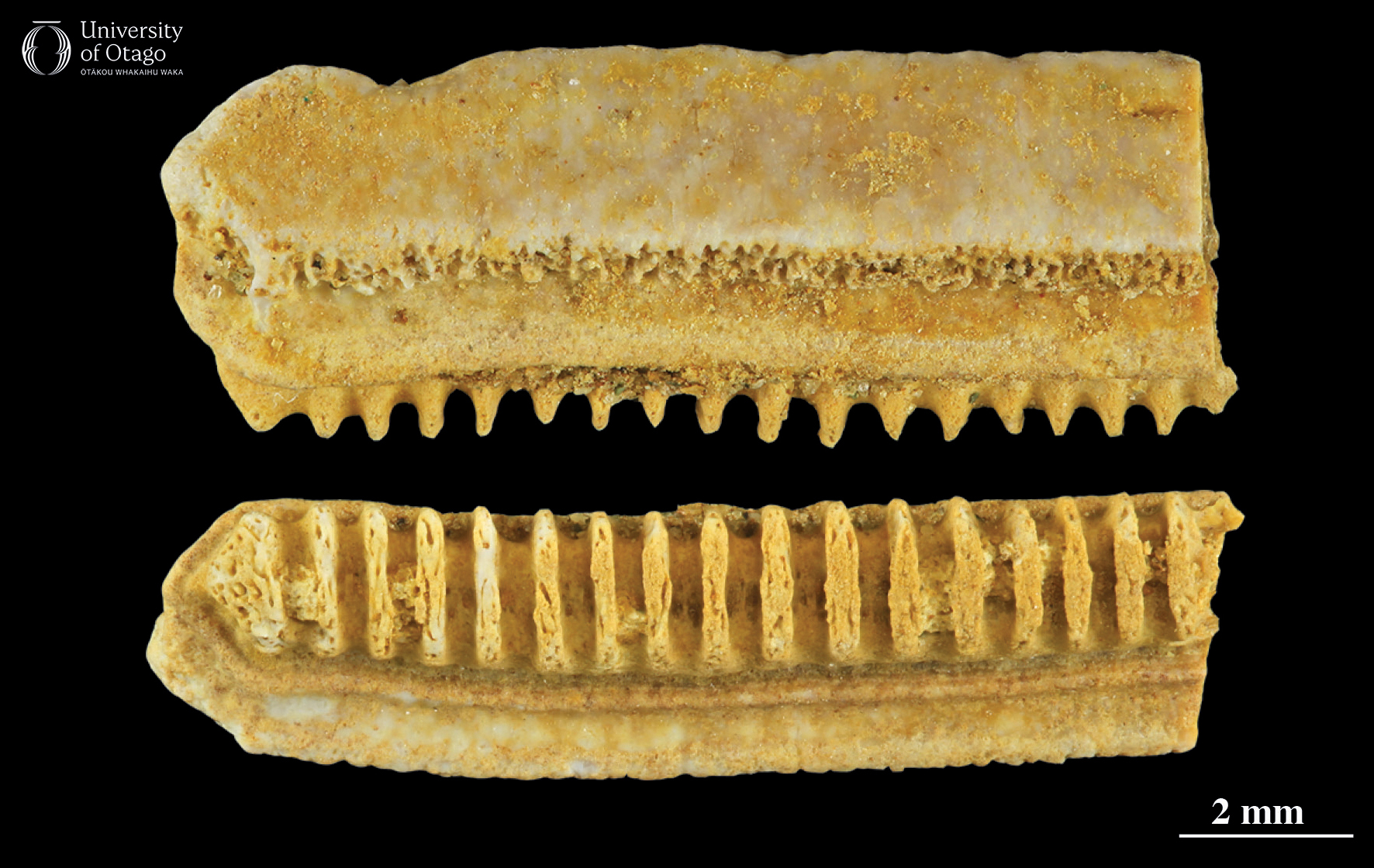3 Stingrays: opportunities for discovery
Chondrichthyes, Myliobatiformes
Despite being an ecologically-important group of vertebrates in Aotearoa New Zealand and around the world, and being found relatively commonly as fossils, New Zealand fossil stingrays have received very little attention. Indeed, while there are examples of fossil sharks, fossil sawsharks, and fossil bony fish from New Zealand that have been identified as distinct species (see Giant moonfish buried three layers deep), the same level of description has never been reported for a fossil stingray from New Zealand. Which means that at the time of writing, there are many opportunities to contribute to the New Zealand fossil record by studying and describing stingrays.
|
Two views of a tooth plate from an unidentified species of stingray (specimen OU 22788). The upper view shows the side of the tooth plate with the occlusal surface (i.e. food-grinding surface) towards the top. The lower view shows the ridges on the ventral side (underneath side) that anchor the tooth plate into the jaw. Image credit: JH Robinson. |
One of the challenges faced with describing ancient stingrays is that their skeletons are almost entirely constructed from cartilage which tends to break down before it can be preserved in the fossil record. Fortunately, stingrays have tooth plates that are constructed from mineralised tissues and which preserve very well as fossils. These tooth plates have a distinctive shape as they are narrow bars with a smooth occlusal surface on one side (surface for processing food), while on the opposite side there is a surface with ridges where the tooth is embedded into the jaw. Stingrays use their tooth plates to crush the carapaces of crabs and the shells of bivalves, their most common types of prey. Hence, the parts of the stingray skeleton that is most likely to preserve as a fossil is also likely to be informative about ancient diet.
There are many locations across New Zealand where fossil tooth plates have been found. For example, the University of Otago Geology Museum collections include stingray tooth plates from Cosy Dell and Brydone in Southland. This material is a great starting point for any paleontologist who aspires to fill in the major gap in the New Zealand fossil record by studying ancient stingrays.
—Written by Daniel B Thomas
| Specimen number: OU 22788 | Age: Approximately 26 million years old (Oligocene, Duntroonian stage) |
| Locality: Waimumu, Southland | Rock Formation: Chatton Formation |
| Collected by: GSNZ fieldtrip attendee | |
| Citation: Lee D, Lindqvist J, Beu A, Robinson J, Ayress M, Morgans H, Stein J. 2014. Geological setting and diverse fauna of a Late Oligocene rocky shore ecosystem, Cosy Dell, Southland. New Zealand Journal of Geology and Geophysics 57:195–208. doi.org/10.1080/00288306.2014.898666 | |
Animals that have bony tissues (e.g. vertebrae, teeth) and are quadroblastic (i.e. four germ-layers: endoderm, mesoderm, ectoderm and neural crest tissue).
Evidence of life from a past geological age. Remains like bones, shells or wood, or an impression like a footprint, or some other evidence of life, from something that was alive more than 11,700 years ago.
Cartilaginous fish known for their flattened bodies and long, thin tails. Stingrays are all animals within order Myliobatiformes.
Firm, flexible connective tissue found. One of two major components in the skeleton of all vertebrates (with the other being a calcium phosphate mineral).
Connective tissues with a high proportion of accumulated minerals, generally a calcium phosphate mineral (bone) or a calcium carbonate mineral (shell). Mineralised tissues including bones and teeth are harder and more durable than cartilage-only skeletal tissues.
The surface of a tooth or tooth plate that comes into contact with another tooth or tooth plate when the jaw is closed.
Outer shell.


